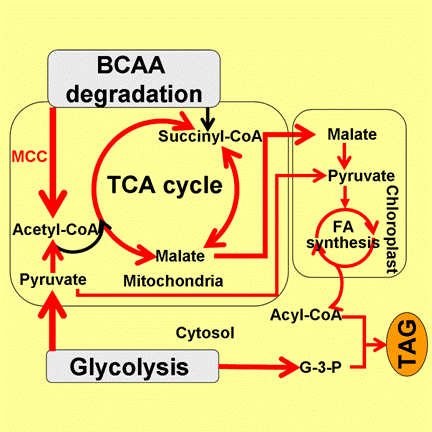
Scientists Reveal Methylcrotonyl-CoA Carboxylase as a Novel Regulator of Triacylglycerol Accumulation in Diatom
May 12, 2014 Email"> PrintText Size


Putative Simplified Model of Metabolic Pathways Responsible for TAG Accumulation (Image by IHB)
Diatoms are a diverse group of eukaryotic, unicellular, photosynthetic microalgae believed to be responsible for about 40% of the total carbon fixation in the oceans and 20% of the primary production on Earth. In addition to the important roles of diatoms in aquatic ecosystems and the global cycling of carbon, under certain circumstances some diatoms can store carbon and energy in the form of lipids (predominantly triacylglycerols [TAGs]), making it an attractive system for biodiesel production, but the mechanism underlying TAG accumulation is unclear.
The research group led by Dr. HU Hanhua at Institute of Hydrobiology, Chinese Academy of Sciences (IHB) found that gene encoding methylcrotonyl-CoA carboxylase (MCC) was up-regulation after nitrogen exhaustion in the culture of Phaeodactylum tricornutum, a model diatom via suppression subtractive hybridization technology. Subsequent qRT-PCR and western blot analysis further revealed that genes associated with branched-chain amino acid (BCAA) degradation were significantly up-regulated at both the mRNA and protein levels during TAG accumulation. The most significantly up-regulated gene, encoding the β subunit of MCC (MCC2), was selected for further functional studies. Inhibition of MCC2 expression by RNA interference disturbed the flux of carbon (mainly in the form of leucine) towards BCAA degradation, resulting in decreased TAG accumulation. MCC2 inhibition also gave rise to incomplete utilization of nitrogen, thus lowering biomass during the stationary growth phase. These findings help elucidate the molecular and metabolic mechanisms leading to increased lipid production in diatoms.
This work was published online in The Plant Cell with the title "Methylcrotonyl-CoA Carboxylase Regulates Triacylglycerol Accumulation in the Model Diatom Phaeodactylum tricornutum" on 25th April.
Putative Simplified Model of Metabolic Pathways Responsible for TAG Accumulation (Image by IHB)
Diatoms are a diverse group of eukaryotic, unicellular, photosynthetic microalgae believed to be responsible for about 40% of the total carbon fixation in the oceans and 20% of the primary production on Earth. In addition to the important roles of diatoms in aquatic ecosystems and the global cycling of carbon, under certain circumstances some diatoms can store carbon and energy in the form of lipids (predominantly triacylglycerols [TAGs]), making it an attractive system for biodiesel production, but the mechanism underlying TAG accumulation is unclear. 
The research group led by Dr. HU Hanhua at Institute of Hydrobiology, Chinese Academy of Sciences (IHB) found that gene encoding methylcrotonyl-CoA carboxylase (MCC) was up-regulation after nitrogen exhaustion in the culture of Phaeodactylum tricornutum, a model diatom via suppression subtractive hybridization technology. Subsequent qRT-PCR and western blot analysis further revealed that genes associated with branched-chain amino acid (BCAA) degradation were significantly up-regulated at both the mRNA and protein levels during TAG accumulation. The most significantly up-regulated gene, encoding the β subunit of MCC (MCC2), was selected for further functional studies. Inhibition of MCC2 expression by RNA interference disturbed the flux of carbon (mainly in the form of leucine) towards BCAA degradation, resulting in decreased TAG accumulation. MCC2 inhibition also gave rise to incomplete utilization of nitrogen, thus lowering biomass during the stationary growth phase. These findings help elucidate the molecular and metabolic mechanisms leading to increased lipid production in diatoms.
This work was published online in The Plant Cell with the title "Methylcrotonyl-CoA Carboxylase Regulates Triacylglycerol Accumulation in the Model Diatom Phaeodactylum tricornutum" on 25th April.
CAS Institutes
There are 124 Institutions directly under the CAS by the end of 2012, with 104 research institutes, five universities & supporting organizations, 12 management organizations that consist of the headquarters and branches, and three other units. Moreover, there are 25 legal entities affiliated and 22 CAS invested holding enterprisesThere are 124 I...>> more
Contact Us

Chinese Academy of Sciences
Add: 52 Sanlihe Rd., Xicheng District, Beijing, China
Postcode: 100864
Tel: 86-10-68597592 (day) 86-10-68597289 (night)
Fax: 86-10-68511095 (day) 86-10-68512458 (night)
E-mail: cas_en@cas.cn

